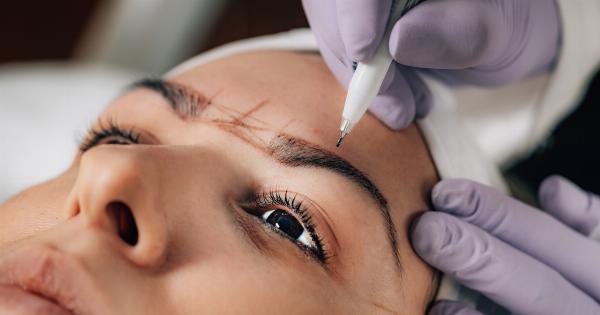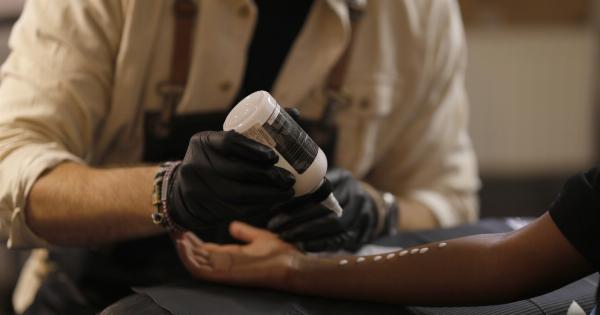Tattoos have become increasingly popular in recent years, serving as a form of self-expression and creativity. However, there may come a time when you decide that getting rid of a tattoo is the right choice for you.
Whether it’s due to a change in personal circumstances, a desire for a fresh start, or simply because you no longer resonate with the design, tattoo removal is now a viable option.
What are the Different Methods of Tattoo Removal?
There are several methods available for tattoo removal. Here are the most common options:.
1. Laser Tattoo Removal
One of the most popular methods of tattoo removal is laser treatment. This technique uses specialized laser technology to break down the tattoo ink into smaller particles, which are then naturally eliminated by the body’s immune system.
Laser tattoo removal is effective, but it often requires multiple sessions to achieve complete removal, depending on factors such as ink color, tattoo size, and the age of the tattoo.
2. Surgical Excision
Surgical excision involves removing the tattooed skin through a surgical procedure. This method is typically used for smaller tattoos and can result in scarring. It may be a suitable option if you want to remove the tattoo entirely rather than fading it.
3. Dermabrasion
Dermabrasion is a technique that involves “sanding” the skin to remove the upper layers, including the tattooed skin. This method is effective for smaller tattoos and may require several sessions to achieve the desired results.
Dermabrasion can be quite painful, and the healing process can take several weeks.
4. Tattoo Removal Creams
Tattoo removal creams are available over the counter and are considered a non-invasive method of tattoo removal. These creams work by fading the tattoo over time, but they are generally less effective than other methods.
It’s important to note that not all tattoo removal creams are safe or reliable, and consulting a dermatologist is recommended before trying any DIY removal methods.
What Factors Affect the Success of Tattoo Removal?
Several factors can influence the success of tattoo removal. These include:.
1. Tattoo Color
The color of your tattoo plays a significant role in the removal process. Darker colors like black and blue tend to absorb more laser energy and are generally easier to remove, while lighter colors like yellow and green may require additional sessions.
2. Tattoo Age
Older tattoos are typically easier to remove compared to newer ones. This is because the ink particles have had more time to fade and break down naturally.
3. Tattoo Size
Larger tattoos require more sessions to remove completely, as there is more area to cover. The size also affects the cost and time commitment involved in the removal process.
4. Skin Tone
The effectiveness of laser tattoo removal can vary depending on your skin tone. People with lighter skin tones generally respond better to treatment, while individuals with darker skin tones may have a higher risk of pigmentation changes.
How Long Does the Tattoo Removal Process Take?
The tattoo removal process is a journey, and it takes time to achieve the desired results. Several factors contribute to the overall duration, including:.
1. Treatment Sessions
The number of treatment sessions required depends on various factors such as the tattoo’s size, color, and age, as well as your skin type and the laser technology used.
On average, it may take anywhere from 5 to 15 sessions, spaced several weeks apart, to achieve significant fading or complete removal.
2. Healing Periods
After each laser treatment session, your skin needs time to heal before the next session can take place. This usually involves a healing period of 4 to 8 weeks, allowing your body to flush out the ink particles that have been fragmented by the laser.
3. Individual Response
Every individual’s response to tattoo removal can vary. Factors such as your body’s ability to eliminate ink particles, your overall health, and your lifestyle choices can influence the speed at which the tattoo fades or disappears.
Can Tattoo Removal Lead to Scarring?
While most tattoo removal techniques aim to minimize scarring, there is always a risk of scarring, particularly with certain methods. Surgical excision, for example, involves cutting out the tattooed skin, which will result in a scar.
Laser tattoo removal and dermabrasion carry a lower risk of scarring, but individual factors such as skin type, aftercare, and the size and location of the tattoo can affect the likelihood of scarring.
What Does Tattoo Removal Feel Like?
The sensation experienced during tattoo removal varies depending on the individual’s pain tolerance and the removal method used.
Laser tattoo removal is often described as feeling similar to getting a tattoo, with the laser pulses creating a snapping or stinging sensation. Some people compare it to the sensation of a rubber band being snapped against the skin. However, numbing creams or local anesthesia can be applied before the treatment to minimize discomfort.
What Are the Possible Side Effects of Tattoo Removal?
As with any medical procedure, tattoo removal is associated with some potential side effects. These can include:.
1. Swelling and Redness
Immediately after a laser treatment session, it is common to experience some swelling and redness in the treated area. This should subside within a few days.
2. Blistering and Scabbing
In some cases, laser treatment may cause blisters or scabs to form. These are part of the natural healing process and will disappear as your skin heals.
3. Hyperpigmentation or Hypopigmentation
In rare cases, laser tattoo removal can lead to changes in skin pigmentation. Hyperpigmentation causes the skin to darken, while hypopigmentation results in lighter patches. These side effects are usually temporary but can persist in some cases.
Choosing the Right Tattoo Removal Professional
When considering tattoo removal, it is essential to choose a qualified and experienced professional. Look for a reputable clinic or dermatologist specializing in tattoo removal and schedule a consultation to discuss your options.
Make sure to ask about the practitioner’s qualifications, experience with the specific removal method, and potential side effects.
Conclusion
Tattoo removal is a personal decision that can provide a fresh start or help you move on from a design that no longer resonates with you.
With the advancements in technology and various removal methods available, it is possible to effectively remove or fade unwanted tattoos. Consider the factors discussed, consult with a professional, and choose the method that suits your needs and desired outcome. Patience and proper aftercare throughout the removal process will help you achieve the best results.


























